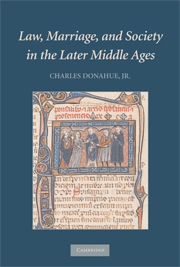Book contents
- Frontmatter
- Contents
- List of Tables
- List of Appendices
- Preface
- Acknowledgments
- Notes About This Book
- Introduction
- 1 The Background Rules and Institutions
- 2 Lying Witnesses and Social Reality: Four English Marriage Cases in the High Middle Ages
- 3 Statistics: The Court of York, 1300–1500
- 4 Story-Patterns in the Court of York in the Fourteenth Century
- 5 Story-Patterns in the Court of York in the Fifteenth Century
- 6 Ely
- 7 Paris
- 8 Cambrai and Brussels: The Courts and the Numbers
- 9 Cambrai and Brussels: The Content of the Sentences
- 10 Divorce a mensa et thoro and salvo iure thori (Separation)
- 11 Social Practice, Formal Rule, and the Medieval Canon Law of Incest
- 12 Broader Comparisons
- Epilogue and Conclusion
- Bibliography and Abbreviations
- Subject Index
- Texts and Commentary
- Table of Cases
- Table of Authorities
- Index of Persons and Places
Introduction
Published online by Cambridge University Press: 14 July 2009
- Frontmatter
- Contents
- List of Tables
- List of Appendices
- Preface
- Acknowledgments
- Notes About This Book
- Introduction
- 1 The Background Rules and Institutions
- 2 Lying Witnesses and Social Reality: Four English Marriage Cases in the High Middle Ages
- 3 Statistics: The Court of York, 1300–1500
- 4 Story-Patterns in the Court of York in the Fourteenth Century
- 5 Story-Patterns in the Court of York in the Fifteenth Century
- 6 Ely
- 7 Paris
- 8 Cambrai and Brussels: The Courts and the Numbers
- 9 Cambrai and Brussels: The Content of the Sentences
- 10 Divorce a mensa et thoro and salvo iure thori (Separation)
- 11 Social Practice, Formal Rule, and the Medieval Canon Law of Incest
- 12 Broader Comparisons
- Epilogue and Conclusion
- Bibliography and Abbreviations
- Subject Index
- Texts and Commentary
- Table of Cases
- Table of Authorities
- Index of Persons and Places
Summary
The law of marriage of Western Europe in the Middle Ages was canon law, and it was complicated. The basic principles, however, of that law from the late twelfth century into the sixteenth were deceptively simple: (1) Present consent freely exchanged between a man and a woman capable of marriage makes a marriage that is indissoluble so long as both of them live, unless, prior to the consummation of the marriage, one of them chooses to enter the religious life. (2) Future consent freely exchanged between a man and a woman capable of marriage makes an absolutely indissoluble marriage so long as both of them live, if, subsequent to the exchange of future consent and prior to the formation of another marriage, the couple who have exchanged future consent have sexual intercourse with each other. (3) Any Christian man is capable of marrying any Christian woman so long as: (a) both are over the age of puberty and capable of sexual intercourse; (b) neither was previously married to someone who is still alive; (c) neither has taken a solemn vow of chastity, and the man is not in major orders (subdeacon, deacon, priest, or bishop), and (d) they are not too closely related to each other. This last requirement was, indeed, complicated, but I will argue in this book that it was not so important socially as it used to be – and to some extent still is – thought to be.
- Type
- Chapter
- Information
- Law, Marriage, and Society in the Later Middle AgesArguments about Marriage in Five Courts, pp. 1 - 13Publisher: Cambridge University PressPrint publication year: 2008



